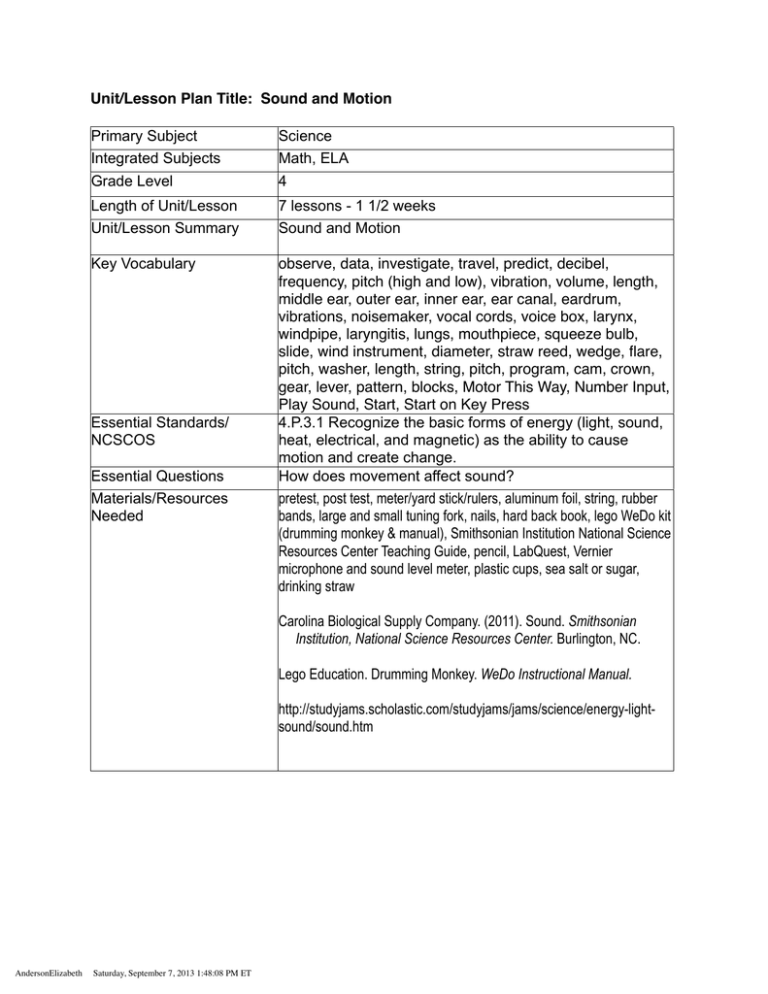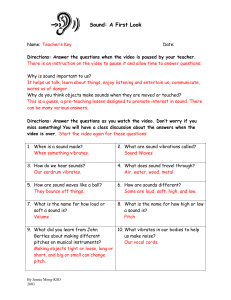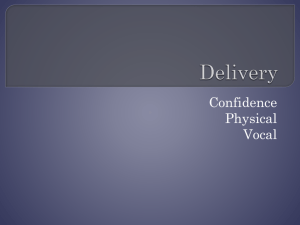Unit/Lesson Plan Title: Sound and Motion Primary Subject Science Integrated Subjects
advertisement

Unit/Lesson Plan Title: Sound and Motion Primary Subject Integrated Subjects Grade Level Science Math, ELA 4 Length of Unit/Lesson Unit/Lesson Summary 7 lessons - 1 1/2 weeks Sound and Motion Key Vocabulary observe, data, investigate, travel, predict, decibel, frequency, pitch (high and low), vibration, volume, length, middle ear, outer ear, inner ear, ear canal, eardrum, vibrations, noisemaker, vocal cords, voice box, larynx, windpipe, laryngitis, lungs, mouthpiece, squeeze bulb, slide, wind instrument, diameter, straw reed, wedge, flare, pitch, washer, length, string, pitch, program, cam, crown, gear, lever, pattern, blocks, Motor This Way, Number Input, Play Sound, Start, Start on Key Press 4.P.3.1 Recognize the basic forms of energy (light, sound, heat, electrical, and magnetic) as the ability to cause motion and create change. How does movement affect sound? pretest, post test, meter/yard stick/rulers, aluminum foil, string, rubber bands, large and small tuning fork, nails, hard back book, lego WeDo kit (drumming monkey & manual), Smithsonian Institution National Science Resources Center Teaching Guide, pencil, LabQuest, Vernier microphone and sound level meter, plastic cups, sea salt or sugar, drinking straw Essential Standards/ NCSCOS Essential Questions Materials/Resources Needed Carolina Biological Supply Company. (2011). Sound. Smithsonian Institution, National Science Resources Center. Burlington, NC. Lego Education. Drumming Monkey. WeDo Instructional Manual. http://studyjams.scholastic.com/studyjams/jams/science/energy-lightsound/sound.htm AndersonElizabeth Saturday, September 7, 2013 1:48:08 PM ET Exploration/Engagement Activities PBL Challenge: Early this morning while Mr. Cameron was unlocking the school, he heard a loud, strange sound. After investigating he discovered a unusual crater located near the playground. Mr. Cameron has marked off the area for your safety. After police, firefighters and local scientists analyzed the crater they have yet discovered what fell from the sky to make this mysterious indentation. Mrs. Tunks has asked you, as young scientists to research and discover what might have have caused this. PBL Challenge for individual lesson: A team of sound analyst is traveling through the jungle trying to identify what is making a particular sound. After days of trudging through mosquito infested jungle, the team discovers a troop of monkeys working in a secret lego tree house. They need your help in identifying the mystery sound. Your job is to build a replica of the monkey and to identify the item making the sound. Please use an interactive whiteboard to document your discovery. Accommodations for Differentiated Instruction partner and small group work Cross Curricular Integration Assessments: •Performance-based •Formative •Summative ELA, Math Extension Activities School wide sharing Created by Elizabeth Anderson Pam Rutherford andersonep@rss.k12.nc.us rutherpr@rss.k12.nc.us Email AndersonElizabeth Saturday, September 7, 2013 1:48:08 PM ET Pretest, post test, interactive whiteboard journaling Sound and Motion Lesson 1: “Group PBL” Materials Needed: PBL Challenge Video site on OES grounds (hole with caution tape), Vocabulary: Problem Based Learning, sound, crater Essential Question: What might cause a large crater? Activity Description of Activities and Setting Objective 4.P.3.1 Recognize the basic forms of energy (light, sound, heat, electrical, and magnetic) as the ability to cause motion and create change. Exploration/ Engagement Activities PBL Challenge Video Early this morning while Mr. Cameron was unlocking the school, he heard a loud, strange sound. After investigating he discovered a unusual crater located near the playground. Mr. Cameron has marked off the area for your safety. After police, firefighters and local scientists analyzed the crater they have yet discovered what fell from the sky to make this mysterious indentation. Mrs. Tunks has asked you, as young scientists to research and discover what might have have caused this. Facilitate a discussion to get students to tell what they “know” from the PBL challenge. Ask students to list “questions that needed to be answered in order to discover what might have caused the crater.” AndersonElizabeth Assessment Ability to participate in generating a list of what is known from the PBL and formulating questions as a formative assessment. Supporting Documents iMovie Trailer for Group PBL Saturday, September 7, 2013 1:48:08 PM ET Sound and Motion Lesson 2: “How Sound Travels” Materials Needed: Science notebook plastic tray wooden meterstick or yardstick 1 piece of aluminum foil, 1 m long 1 piece of string, 1 m long 1 large tuning fork 1 small tuning fork wood metal nails glass rods Vocabulary: observe, data, investigate, travel, vibration Essential Questions: ! 1. How does sound travel? Activity Focus/Review Description of Activities and Setting Refer to the class charts labeled “Sounds We Have Heard” and “Ways to Make Sounds.” Challenge students to think about various sounds and how they think these sounds are made. Show the Study Jams Video on how sound travels. Objectives AndersonElizabeth •Students will listen to and describe sounds that are produced by tuning forks and that pass through different materials. •Students will compare and discuss the loudness of the sounds heard. •Students will compare and discuss what they know about how the materials vibrate. •Students will devise and present demonstrations to support their ideas. Saturday, September 7, 2013 1:48:08 PM ET Exploration/ Engagement Activities To produce a sound with the tuning fork, hold it by the stem and strike the prongs on a soft surface – such as the heel of your hand, your knee, or rubber sole of a shoe. Do not strike the tuning forks on hard surfaces. How far away can you hear the tuning fork? What does it the tuning fork feel like when ringing? What happens to the sound when you hold the prongs instead of holding the stem? After striking the tuning fork put the stem on the bone of in front of your ear. What happens to the sounds when you do this? Why? What are the similarities and differences between the small and large tuning forks? How does the length affect the pitch? You will see the frequency and musical note stamped on each turning fork. For example the small tuning fork vibrates at a frequency of 512 Hz and is the musical note C. How does the frequency affect the pitch? Investigate how sound and vibrations travel through several materials provided: wood, string, aluminum, metal nails, glass rods, etc. Hold a ringing tuning fork at one end and listen for sound and feel for vibrations at the other end. Listen and feel at different distances from the ringing tuning fork. Record you observations in the data table. Assessment AndersonElizabeth Students will record their observations in the data table. Saturday, September 7, 2013 1:48:08 PM ET Supporting Documents Study Jams Video: http://studyjams.scholastic.com/studyjams/jams/science/ energy-light-sound/sound.htm Data Table: How Sound Travels Through Various Materials AndersonElizabeth Saturday, September 7, 2013 1:48:08 PM ET Sound and Motion Lesson 3: “Making Sounds” Materials Needed: Science notebook plastic tray nails rulers pencil LabQuest or LabQuest 2 Vernier Microphone Probe Vernier Sound Level Meter Vocabulary: predict, decibel, frequency, pitch (high and low), vibration, volume, length Essential Questions: ! 1. How are sounds produced? Activity Objective AndersonElizabeth Description of Activities and Setting •Students will make sounds by striking nails and vibrating rulers and investigate properties of pitch. Saturday, September 7, 2013 1:48:08 PM ET Exploration/ Engagement Activities Place the three nails on the foam and strike the nails with the eraser of pencil. The nails are placed on the foam so that the sound will last longer than it would on a hard surface. Do all the nails sound the same? Why or Why not? How does the length of the nail affect the pitch? To produce a sound on a ruler firmly hold one end of the ruler on the table and extend the other end over the edge of the table. Pluck the free end of the ruler to cause it to produce a sound. Why does plucking the ruler create sound? Complete Record Sheet 4-A by making predictions and observations about what you hear and see when vibrating the ruler with various lengths. Is there a relationship between the length of the ruler over the table edge and the pitch? Is there a range of lengths where no sound is produced? Why isn’t there a sound? What happens if after plucking the ruler you move the ruler to shorten the length? Did you have any additional observation and questions/ answers when playing with the nails and rulers? Use the LabQuest Microphone and Sound Level meter to measure volume and look at the waveforms. AndersonElizabeth Assessment Students will record their observations on the Record Sheet 4-A Supporting Documents Record Sheet 4-A Saturday, September 7, 2013 1:48:08 PM ET Sound and Motion Lesson 4: “Making Sounds” Materials Needed: Science notebook plastic tray Jumbo drinking straw narrow rubber band wide rubber band plastic cup noisemaker salt, sugar, or fine sand LabQuest or LabQuest 2 Vernier Microphone Probe Vocabulary: middle ear, outer ear, inner ear, ear canal, eardrum, vibrations, noisemaker, vocal cords, voice box, larynx, windpipe, laryngitis, lungs Essential Questions: ! 1. How can sound vibrations cause other objects to vibrate? Activity Objective AndersonElizabeth Description of Activities and Setting •Students will experiment with models of the eardrum and vocal cords. Saturday, September 7, 2013 1:48:08 PM ET Exploration/ Engagement Activities A model of the vocal cords can be created by stretching rubber bands over a plastic cup. Eardrum To make a model eardrum stretch the rubber square tightly over the cup and secure it with a rubber band. Pull the edges of the rubber square so it’s stretched as tightly as possible. Place some sugar, salt, sand, or small pieces of tissue paper on the rubber square. Hold the noisemaker above the eardrum and turn the handle or strike a turning fork above the eardrum. What do you observe? Is there any motion of the sugar? How would loud sounds damage your eardrum? Vocal Cords Try to produce sound by blowing gently through the straw unto the rubber bands. Experiment with ways to produce different sounds of different frequency. How was the sound produced? What are some ways that you were able to change the pitch? Place your hand against your throat and begin to speak. What do you observe? Say “Hello” in a low voice and then in a high voice. Do you feel anything different when you change the pitch of your voice? What about changing the volume of your voice? AndersonElizabeth Saturday, September 7, 2013 1:48:08 PM ET What do you feel on your throat when you say and hold the following sounds? Vowels like “a” Consonants like t, s, z, m, n – you may have to surround the consonant with a vowel like “ada” Other sounds like buzzing your lips, saying “uh-oh”, whistling, etc. LabQuest Connect the microphone to the LabQuest. In the LabQuest App go to the Graph Screen. If you click the start button it will record the sound pressure for 0.030 seconds to create a waveform on the graph. If you want to see the waveform of a particular sound you must create the sound before hitting start. Look at the waveforms of various sounds – noisemaker, drum, tuning fork, speaking, making the sounds listed above. Under the “Analyze” menu on the graph screen click on “FFT” and “Sound Pressure”. This will produce a graph of the amplitudes over all the frequencies. Using this graph you can see what frequencies (pitches) where present in the recorded sound. What are you observations and/or questions/answers? Assessment Respond to reading in a science journal. Supporting Documents Reading Selection: “Protecting Our Hearing” Reading Selection: “Making Sounds with Our Vocal Cords” AndersonElizabeth Saturday, September 7, 2013 1:48:08 PM ET Sound and Motion Lesson 5: “Sound in Air Columns” Materials Needed: Science notebook plastic tray whistle mouthpiece plastic tube, 15 mm diameter, 10.5 cm long 1 squeeze bulb 1 wooden dowel, 14 mm diameter, 15 cm long plastic ruler 6 Jumbo drinking straws 6 Super Jumbo drinking straws hole punch scissors Vocabulary: mouthpiece, squeeze bulb, slide, wind instrument, diameter, straw reed, wedge, flare, pitch Essential Questions: ! 1. How can sound be produced by a vibrating column of air? Activity Objective AndersonElizabeth Description of Activities and Setting •Students will experiment with sounds in air columns using whistles, bottles, and reed instruments. Saturday, September 7, 2013 1:48:08 PM ET Exploration/ Engagement Activities Slide Whistle Create sound on the slide whistle by squeezing the squeeze bulb. Keeping the length constant what happens to the pitch when you force more or less air through the whistle? What happens to the pitch as you slide the slide in and out? Measure and record the length of the air column (not the length of the slide) at different pitches. Bottles Make sure the bottle in the ice is empty. Empty one of the room temperature bottles. Blow across the bottle openings of the room temperature and cold empty bottles. Is there a different in sound? Why or why not? Fill the two room temperature bottles with different levels. Is there a difference in pitch? Why or why not? How does the pitch depend on the length of the air column? How does the pitch depend on the height of the water? AndersonElizabeth Saturday, September 7, 2013 1:48:08 PM ET Reed Instrument: Straw Whistle Follow the Instructions for making a straw reed instrument. Note: It’s easier to flatten the straw before cutting. If the straw isn’t flat enough it won’t play. Flattening the straw with your teeth works better than with your fingers. Make sure you cut the wedge 1 cm as shown, if it’s too short or long it won’t play. Make an instrument with finger holes and/or with a slide. What differences are there between the finger hole and slide instrument? How does length and style affect the pitch and volume? Place the open end of the straw in your closed hand. As you play the reed straw open and close your hand. How does the shape and size of the cavity affect the sound , volume, and pitch? Assessment Respond to reading in a science journal. Supporting Documents Assembling a Slide Whistle Making Straw Reed Instruments AndersonElizabeth Saturday, September 7, 2013 1:48:08 PM ET Sound and Motion Lesson 6: “Sounds on Vibrating Strings” Materials Needed: Science notebook plastic tray string cardboard plastic cup small steel washer unsharpened pencil Vocabulary: washer, length, string, pitch Essential Questions: ! 1. How can you make sounds with string? Activity Description of Activities and Setting Objective •Students will experiment with sounds in strings of various lengths, tensions, and thicknesses Exploration/ Engagement Activities Making Sounds with String Unwind the nylon string form the cardboard. Pass the free end of the nylon string through the hole in the plastic cup and pull all the way through until so that the washer is inside the cup. Wrap the free end around a pencil. Hold the cup against the floor with one foot and pluck the string. What changes when you pluck harder? Keeping the length the same, pull on the string to increase the tension. How does the tension affect the pitch? What happens to the pitch when the length of the string is increased and decreased? Are there other ways to produce sound on the string? AndersonElizabeth Saturday, September 7, 2013 1:48:08 PM ET AndersonElizabeth Assessment Respond to reading in a science journal. Supporting Documents None Saturday, September 7, 2013 1:48:08 PM ET Sound and Motion Lesson 7: “Monkey Business” Materials Needed: Science notebook Laptop iPad bucket of materials WeDo Lego Kit WeDo Instructional Manual for the Drumming Monkey Vocabulary: program, cam, crown, gear, lever, pattern, blocks, Motor This Way, Number Input, Play Sound, Start, Start on Key Press Essential Question: ! 1. How are sounds produced? Activity Description of Activities and Setting Objectives •Students will create a Lego Drumming Monkey. •Students will use various materials to create the mystery sound. Exploration/ Engagement Activities Teacher will show the iMovie for the PBL challenge. Using the WeDo Instructional Manual for the Drumming Monkey, students will construct a Drumming Monkey model. After students construct the model, they will use the bucket of materials to find the mystery sound from the PBL. Assessment Respond to reading in a science journal. Supporting Documents Drumming Monkey Teacher Notes PBL Blueprint Planning Form iMovie Trailer Flipchart: “Monkey Business” AndersonElizabeth Saturday, September 7, 2013 1:48:08 PM ET



